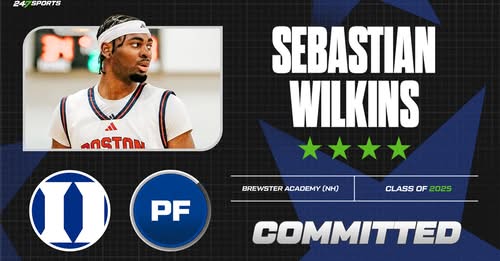Sebastian Wilkins is headed to Durham. The three-star forward out of Georgia announced his commitment to Duke on Sunday afternoon, becoming the latest addition to Jon Scheyer’s growing 2025 recruiting class. For Wilkins, the decision marks the culmination of months of evaluation, development, and careful consideration. For Duke, it’s another important puzzle piece in a class that continues to blend blue-chip potential with high-upside role players who fit the program’s culture and long-term vision.
Wilkins, a 6-foot-8, 210-pound forward from Grayson High School, isn’t the type of prospect that typically dominates the headlines in Duke’s historically star-studded recruiting hauls. But ask those close to the situation—whether it’s AAU coaches, college scouts, or Scheyer himself—and they’ll tell you the same thing: Wilkins is one of the most underrated prospects in the country. Long, athletic, defensively versatile, and increasingly confident on the offensive end, Wilkins represents the type of high-ceiling, low-ego player that Duke has targeted more frequently under Scheyer’s watch.
His rise through the recruiting rankings has been steady, if unspectacular, over the past year. Initially viewed as a raw but athletic forward with limited perimeter skills, Wilkins has made notable strides in his shooting mechanics and decision-making. His outside shot, once considered a liability, has become far more consistent, particularly off the catch. His improved range now forces defenders to respect his shot, opening up lanes for him to attack closeouts or facilitate from the high post. His ball-handling has also come a long way, allowing him to be more than just a rim-runner or dunker in transition.
More than the stats or star rating, what caught Duke’s eye was Wilkins’ motor. The Blue Devils pride themselves on effort, defensive intensity, and playing with purpose—traits Wilkins has shown in abundance. He’s a willing rebounder, a high-energy defender capable of switching onto guards, and someone who rarely takes possessions off. On a team loaded with scoring options, Wilkins doesn’t need the ball to make an impact. He plays within himself and thrives doing the little things that don’t always show up on the stat sheet.
While some programs may have hesitated due to his three-star label, Duke’s staff saw value in his trajectory and potential. Assistant coach Chris Carrawell was reportedly instrumental in Wilkins’ recruitment, keeping in close contact with the forward and his inner circle. The Blue Devils watched him multiple times during the spring AAU circuit and were impressed not just by his physical tools, but by how well he embraced coaching and responded to adversity on the floor. Those intangible qualities made him stand out in a class where character is becoming just as important as raw skill.
In an era where NIL valuations and social media followings often dominate the recruiting narrative, Wilkins’ recruitment was refreshingly old school. There was no elaborate announcement video, no cryptic Twitter countdowns, no theatrics. Just a young man who did his homework, weighed his options, and chose the program that best aligned with his values and goals. Sources close to Wilkins say that Duke’s emphasis on player development and academic excellence played a major role in his decision, as did the opportunity to be part of something bigger than himself.
That team-first mentality is something Scheyer has emphasized since taking over for Hall of Famer Mike Krzyzewski. While Duke still remains a destination for elite talent—the program landed top-five recruit Cooper Flagg in the 2024 cycle—it has also become a place where late bloomers and glue guys can carve out meaningful roles. In Wilkins, Duke is betting on a player who might not wow fans from day one, but whose value will become more and more apparent as he grows into the system.
Wilkins becomes the third member of Duke’s 2025 recruiting class, joining four-star guard Jaylen Harrell and five-star center Khaman Maluach. Together, the trio brings a well-rounded mix of size, skill, and positional versatility. Harrell is a crafty shot-creator who can play either guard spot, while Maluach offers elite rim protection and offensive upside as a modern big man. Wilkins, with his ability to guard multiple positions and contribute in a variety of ways, is expected to complement both players well.
What’s particularly notable about this class is its balance. Rather than stacking up similar high-usage scorers, the Blue Devils have prioritized complementary pieces who can fill specific roles and develop over time. That’s been a conscious shift under Scheyer, who has often spoken about the importance of roster fit and long-term development. With players like Wilkins, the staff is showing that they’re thinking not just about short-term success, but about building sustainable rosters that can compete deep into March.
Wilkins also brings an intriguing long-term upside. Physically, he has the frame and athleticism to eventually guard at least three positions at the college level. Offensively, he’s shown flashes of being able to stretch the floor and make smart reads as a passer. If he continues to develop at his current rate, there’s reason to believe he could be a major contributor by his sophomore year, if not sooner. Coaches have pointed to his work ethic and maturity as indicators that he won’t be satisfied just being on the roster—he’s coming to Duke to earn his spot and make an impact.
The commitment also underscores Duke’s continued recruiting success in the Southeast. Wilkins is the latest in a long line of Georgia-based players to choose the Blue Devils, following in the footsteps of stars like Wendell Carter Jr. and Jabari Parker, both of whom had ties to the region. Duke’s presence in Georgia—bolstered by assistant coaches with deep AAU and prep connections—has remained strong, and landing Wilkins only strengthens those ties moving forward.
From a strategic standpoint, Wilkins’ versatility gives Scheyer additional lineup flexibility. In small-ball sets, he can play as an undersized five, allowing Duke to switch everything defensively. In more traditional looks, he can slot in as a stretch four or even a wing, depending on matchups. That adaptability is crucial in today’s game, where positionless basketball and defensive switching schemes have become the norm.
Wilkins’ high school coach, Travis Glenn, had nothing but praise for his star forward. “Sebastian is a competitor. He’s one of the hardest-working kids I’ve ever coached, and he’s only scratching the surface of what he can be,” Glenn said. “Duke is getting a young man who’s going to embrace the culture, work every day, and find ways to contribute whether he’s scoring or not. He just wants to win.”
For Wilkins, the commitment is more than just a personal achievement—it’s validation for the work he’s put in and the belief he’s always had in himself. “I’ve always dreamed of playing at the highest level,” he said shortly after announcing his decision. “Duke gives me the opportunity to do that, to grow as a player and a person. I’m excited to get to work and be part of something special.”
That mentality, more than any ranking or highlight reel, is what makes Wilkins such an appealing fit for Duke. He understands that playing for the Blue Devils comes with expectations—both on and off the court. And while some prospects might shy away from that spotlight, Wilkins seems eager to embrace it, knowing full well the opportunity that lies ahead.
With the 2025 class beginning to take shape, Duke fans have reason to be optimistic. The blend of top-tier talent and underrated potential gives the program a foundation that can compete nationally, while also allowing for development and continuity. In an era where roster turnover has become the norm, players like Wilkins offer stability and long-term value.
As the recruiting cycle continues, it remains to be seen whether Duke will add more pieces to its 2025 group. But even if Wilkins is the final addition, the class already looks like a success. For Scheyer and his staff, landing a player like Wilkins isn’t just about filling a roster spot—it’s about reinforcing a culture that prioritizes effort, growth, and team-first basketball.
And for Wilkins, the journey is just beginning. The commitment may be official, but now comes the real work: earning his place, developing his game, and contributing to one of the most storied programs in college basketball. If his past is any indication, he’s more than ready for the challenge.



